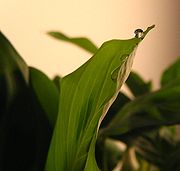
Guttation
Encyclopedia



Xylem
Xylem is one of the two types of transport tissue in vascular plants. . The word xylem is derived from the Classical Greek word ξυλον , meaning "wood"; the best-known xylem tissue is wood, though it is found throughout the plant...
sap
Plant sap
Sap is a fluid transported in xylem cells or phloem sieve tube elements of a plant. It transports water and nutrients throughout the plant....
on the tips or edges of leaves of some vascular plant
Vascular plant
Vascular plants are those plants that have lignified tissues for conducting water, minerals, and photosynthetic products through the plant. Vascular plants include the clubmosses, Equisetum, ferns, gymnosperms and angiosperms...
s, such as grass
Grass
Grasses, or more technically graminoids, are monocotyledonous, usually herbaceous plants with narrow leaves growing from the base. They include the "true grasses", of the Poaceae family, as well as the sedges and the rushes . The true grasses include cereals, bamboo and the grasses of lawns ...
es. Guttation is not to be confused with dew
Dew
[Image:Dew on a flower.jpg|right|220px|thumb|Some dew on an iris in Sequoia National Park]]Dew is water in the form of droplets that appears on thin, exposed objects in the morning or evening...
, which condenses from the atmosphere onto the plant surface.
Process
At night, transpirationTranspiration
Transpiration is a process similar to evaporation. It is a part of the water cycle, and it is the loss of water vapor from parts of plants , especially in leaves but also in stems, flowers and roots. Leaf surfaces are dotted with openings which are collectively called stomata, and in most plants...
usually does not occur because most plants have their stoma
Stoma
In botany, a stoma is a pore, found in the leaf and stem epidermis that is used forgas exchange. The pore is bordered by a pair of specialized parenchyma cells known as guard cells that are responsible for regulating the size of the opening...
ta closed. When there is a high soil moisture level, water will enter plant roots, because the water potential
Water potential
Water potential is the potential energy of water per unit volume relative to pure water in reference conditions. Water potential quantifies the tendency of water to move from one area to another due to osmosis, gravity, mechanical pressure, or matrix effects such as surface tension...
of the roots is lower than in the soil solution. The water will accumulate in the plant, creating a slight root pressure
Root pressure
Root pressure is when roots of two different plants collide. They put pressure against eachother and the two plants form to make one. This is how new plants are created. Root pressure occurs in the xylem of some vascular plants when the soil moisture level is high either at night or when...
. The root pressure forces some water to exude through special leaf
Leaf
A leaf is an organ of a vascular plant, as defined in botanical terms, and in particular in plant morphology. Foliage is a mass noun that refers to leaves as a feature of plants....
tip or edge structures, hydathode
Hydathode
A hydathode is a type of secretory tissue in leaves, usually of Angiosperms, that secretes water through pores in the epidermis or margin of leaves, typically at the tip of a marginal tooth or serration. They probably evolved from modified stomata...
s, forming drops. Root pressure
Root pressure
Root pressure is when roots of two different plants collide. They put pressure against eachother and the two plants form to make one. This is how new plants are created. Root pressure occurs in the xylem of some vascular plants when the soil moisture level is high either at night or when...
provides the impetus for this flow, rather than transpirational pull.
Chemical content
Guttation fluid may contain a variety of organic and inorganic compounds, mainly sugars, and mineral nutrients, and potassium. On drying, a white crust remains on the leaf surface.Analysis
If high levels of nitrogen appear in the fluid, it is a sign of fertilizer burnFertilizer burn
Fertilizer burn is a defined as leaf scorch resulting from over-fertilization, usually referring to excess nitrogen saltsFertilizer burn is the result of desiccation of plant tissues due to chemiosmosis, creating a state of hypertonicity.-Treatment:...
. Excess nitrogen must be leached from the soil by addition of large quantities of water. This may result in water pollution
Water pollution
Water pollution is the contamination of water bodies . Water pollution occurs when pollutants are discharged directly or indirectly into water bodies without adequate treatment to remove harmful compounds....
, but is the best way to restore soil fertility.

